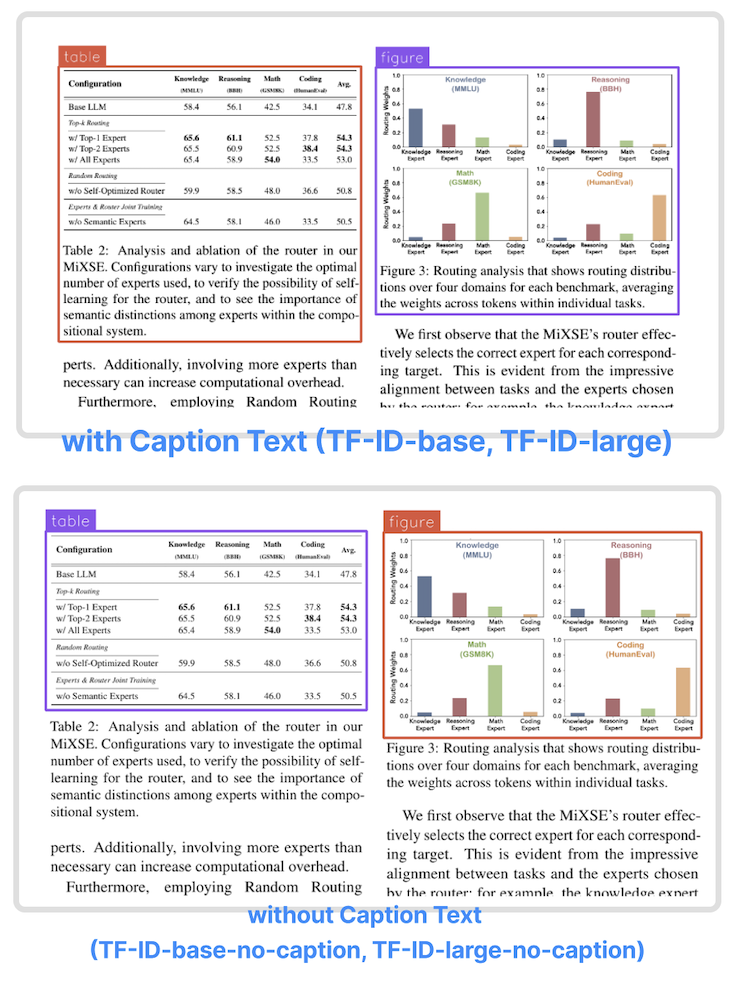File size: 4,501 Bytes
48943f2 55e6417 48943f2 55e6417 48943f2 55e6417 48943f2 55e6417 26b1a96 55e6417 26b1a96 48943f2 |
1 2 3 4 5 6 7 8 9 10 11 12 13 14 15 16 17 18 19 20 21 22 23 24 25 26 27 28 29 30 31 32 33 34 35 36 37 38 39 40 41 42 43 44 45 46 47 48 49 50 51 52 53 54 55 56 57 58 59 60 61 62 63 64 65 66 67 68 69 70 71 72 73 74 75 76 77 78 79 80 81 82 83 84 85 86 87 88 89 90 91 92 93 94 95 96 97 98 |
---
license: mit
license_link: https://huggingface.co/microsoft/Florence-2-base-ft/resolve/main/LICENSE
pipeline_tag: image-text-to-text
tags:
- vision
- ocr
- segmentation
- coco
---
# TF-ID: Table/Figure IDentifier for academic papers
## Model Summary
TF-ID (Table/Figure IDentifier) is a family of object detection models finetuned to extract tables and figures in academic papers. They come in four versions:
| Model | Model size | Model Description |
| ------- | ------------- | ------------- |
| TF-ID-base[[HF]](https://huggingface.co/yifeihu/TF-ID-base) | 0.23B | Extract tables/figures and their caption text
| TF-ID-large[[HF]](https://huggingface.co/yifeihu/TF-ID-large) | 0.77B | Extract tables/figures and their caption text
| TF-ID-base-no-caption[[HF]](https://huggingface.co/yifeihu/TF-ID-base-no-caption) | 0.23B | Extract tables/figures without caption text
| TF-ID-large-no-caption[[HF]](https://huggingface.co/yifeihu/TF-ID-large-no-caption) | 0.77B | Extract tables/figures without caption text
All TF-ID models are finetuned from [microsoft/Florence-2](https://huggingface.co/microsoft/Florence-2-large-ft) checkpoints.
TF-ID models take an image of a single paper page as the input, and return bounding boxes for all tables and figures in the given page.
TF-ID-base and TF-ID-large draw bounding boxes around tables/figures and their caption text.
TF-ID-base-no-caption and TF-ID-large-no-caption draw bounding boxes around tables/figures without their caption text.

Object Detection results format:
{'\<OD>': {'bboxes': [[x1, y1, x2, y2], ...],
'labels': ['label1', 'label2', ...]} }
## Benchmarks
We tested the models on paper pages outside the training dataset. The papers are a subset of huggingface daily paper.
Correct output - the model draws correct bounding boxes for every table/figure in the given page.
| Model | Total Images | Correct Output | Success Rate |
|---------------------------------------------------------------|--------------|----------------|--------------|
| TF-ID-base[[HF]](https://huggingface.co/yifeihu/TF-ID-base) | 258 | 251 | 97.29% |
| TF-ID-large[[HF]](https://huggingface.co/yifeihu/TF-ID-large) | 258 | 253 | 98.06% |
| Model | Total Images | Correct Output | Success Rate |
|---------------------------------------------------------------|--------------|----------------|--------------|
| TF-ID-base-no-caption[[HF]](https://huggingface.co/yifeihu/TF-ID-base-no-caption) | 261 | 253 | 96.93% |
| TF-ID-large-no-caption[[HF]](https://huggingface.co/yifeihu/TF-ID-large-no-caption) | 261 | 254 | 97.32% |
Depending on the use cases, some "incorrect" output could be totally usable. For example, the model draw two bounding boxes for one figure with two child components.
## How to Get Started with the Model
Use the code below to get started with the model.
```python
import requests
from PIL import Image
from transformers import AutoProcessor, AutoModelForCausalLM
model = AutoModelForCausalLM.from_pretrained("microsoft/Florence-2-base-ft", trust_remote_code=True)
processor = AutoProcessor.from_pretrained("microsoft/Florence-2-base-ft", trust_remote_code=True)
prompt = "<OD>"
url = "https://huggingface.co/datasets/huggingface/documentation-images/resolve/main/transformers/tasks/car.jpg?download=true"
image = Image.open(requests.get(url, stream=True).raw)
inputs = processor(text=prompt, images=image, return_tensors="pt")
generated_ids = model.generate(
input_ids=inputs["input_ids"],
pixel_values=inputs["pixel_values"],
max_new_tokens=1024,
do_sample=False,
num_beams=3
)
generated_text = processor.batch_decode(generated_ids, skip_special_tokens=False)[0]
parsed_answer = processor.post_process_generation(generated_text, task="<OD>", image_size=(image.width, image.height))
print(parsed_answer)
```
## BibTex and citation info
```
@article{xiao2023florence,
title={Florence-2: Advancing a unified representation for a variety of vision tasks},
author={Xiao, Bin and Wu, Haiping and Xu, Weijian and Dai, Xiyang and Hu, Houdong and Lu, Yumao and Zeng, Michael and Liu, Ce and Yuan, Lu},
journal={arXiv preprint arXiv:2311.06242},
year={2023}
}
``` |